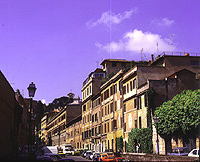Trastevere
Trastevere History
 Trastevere is the closest thing in Central Rome to a medieval town, where the building shapes have changed relatively little for a thousand years. In the Middle Ages (600 AD-1200 AD) there were many towers, like in the Tuscan town of San Gimignano, that served as look-out posts for spotting the enemy and as symbols of a family's power.
Trastevere is the closest thing in Central Rome to a medieval town, where the building shapes have changed relatively little for a thousand years. In the Middle Ages (600 AD-1200 AD) there were many towers, like in the Tuscan town of San Gimignano, that served as look-out posts for spotting the enemy and as symbols of a family's power.
The name Trastevere, (Trans Tiberim), means "across the Tiber". When Rome was founded 27 centuries ago, this area was an Etruscan encampment with Etruria spreading from here to the North (see: Villa Giulia).
The early Romans, sheep farmers, were impressed by their sophisticated neighbors across the river, and chose Etruscans for their first Kings. Things went badly however, in 509 BC, when the Etruscan monarch Tarquinius Superbus (his own title for himself) killed a Roman Senator by kicking him down the Curia steps. Rome rose against Superbus, who quickly asked his Etruscan cousins to help. There ensued a war, which the Romans won - King Superbus wasn't superb any more, and was kicked out. From then on Rome was a Republic.
At the height of the Roman Empire, sailors from Ravenna lived in Trastevere; they were the only ones able to pull the elliptical cover over the Colosseum to protect the spectators on hot or rainy days. Trastevere remained a sailors' quarter until at least the 9 C. In 872 AD Pope John VII recruited men from here to defeat the Saracen invaders at the Battle of Circeo. Foreigners, Jews, tanners, potters, cabinet-makers and gardeners - as well as ladies of easy virtue and thieves - all lived here on the edge, plying their various trades.
Around 800 AD a number of powerful women manned the towers of Rome and even imposed their will on the Popes. This didn't last long, and the backlash imposed repression and restrictions on them. Women, especially nuns, were forced behind screens when in church, and had to wear shapeless garments with large face-covering scarves.
There are many modern entries as well as those of the Dark Ages, but this walk will give a definite flavor of those days. (Don't forget: women should keep their handbags on the building side of the street as they walk - like that robbers on motorbikes cannot snatch them).